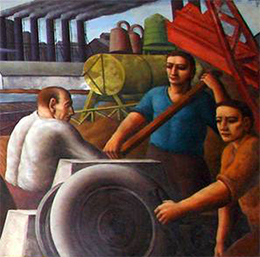| << Chapter < Page | Chapter >> Page > |
In 1935, Congress also passed the Emergency Relief Appropriation Act, which authorized the single largest expenditure at that time in the country’s history: $4.8 billion. Almost one-third of those funds were invested in a new relief agency, the Works Progress Administration (WPA). Harry Hopkins, formerly head of the CWA, took on the WPA and ran it until 1943. In that time, the program provided employment relief to over eight million Americans, or approximately 20 percent of the country’s workforce. The WPA funded the construction of more than 2,500 hospitals, 5,900 schools, 570,000 miles of road, and more. The WPA also created the Federal One Project, which employed approximately forty thousand artists in theater, art, music, and writing. They produced state murals, guidebooks, concerts, and drama performances all around the country ( [link] ). Additionally, the project funded the collection of oral histories, including those of former slaves, which provided a valuable addition to the nation’s understanding of slave life. Finally, the WPA also included the National Youth Administration (NYA), which provided work-study jobs to over 500,000 college students and four million high school students.

Browse the Born in Slavery collection to examine personal accounts of former slaves, recorded between 1936 and 1938, as part of the Federal Writers' Project of the WPA.
With the implementation of the Second New Deal, Roosevelt also created the country’s present-day social safety net. The Social Security Act established programs intended to help the most vulnerable: the elderly, the unemployed, the disabled, and the young. It included a pension fund for all retired people—except domestic workers and farmers, which therefore left many women and African Americans beyond the scope of its benefits—over the age of sixty-five, to be paid through a payroll tax on both employee and employer. Related to this act, Congress also passed a law on unemployment insurance, to be funded by a tax on employers, and programs for unwed mothers, as well as for those who were blind, deaf, or disabled. It is worth noting that some elements of these reforms were pulled from Roosevelt detractors Coughlin and Townsend; the popularity of their movements gave the president more leverage to push forward this type of legislation.
To the benefit of industrial workers, Roosevelt signed into law the Wagner Act, also known as the National Labor Relations Act. The protections previously afforded to workers under the NIRA were inadvertently lost when the Supreme Court struck down the original law due to larger regulatory concerns, leaving workers vulnerable. Roosevelt sought to salvage this important piece of labor legislation, doing so with the Wagner Act. The act created the National Labor Relations Board (NLRB) to once again protect American workers’ right to unionize and bargain collectively, as well as to provide a federal vehicle for labor grievances to be heard. Although roundly criticized by the Republican Party and factory owners, the Wagner Act withstood several challenges and eventually received constitutional sanction by the U.S. Supreme Court in 1937. The law received the strong support of John L. Lewis and the Congress of Industrial Organizations who had long sought government protection of industrial unionism, from the time they split from the American Federation of Labor in 1935 over disputes on whether to organize workers along craft or industrial lines. Following passage of the law, Lewis began a widespread publicity campaign urging industrial workers to join “the president’s union.” The relationship was mutually beneficial to Roosevelt, who subsequently received the endorsement of Lewis’s United Mine Workers union in the 1936 presidential election, along with a sizeable $500,000 campaign contribution. The Wagner Act permanently established government-secured workers’ rights and protections from their employers, and it marked the beginning of labor’s political support for the Democratic Party.

Notification Switch
Would you like to follow the 'U.s. history' conversation and receive update notifications?